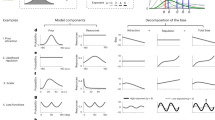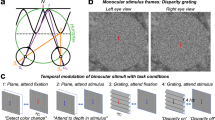Abstract
CELLS in the visual system respond well to spatial discontinuities in luminance (edges), but they are poorly activated by diffuse light1. It has been proposed2 that the selective response of edge-detectors to properties such as orientation and motion underlies form and pattern perception. In these terms, local discontinuity within the visual display is a necessary condition for perception of an edge. There are, however, anomalous contour effects3 (see examples in Fig. 1a and 16) in which edges are clearly visible at sites where the visual stimulus is homogeneous. Such edges have been called subjective or cognitive contours on the supposition that cues to apparent depth within the display lead the observer to infer that he is seeing one plane located in front of, and interrupting, another plane4,5. In these terms, “Since every plane must have an edge, the bounding contour is supplied by the perceptual system … a subjective contour is simply the edge of a subjective plane, and a subjective plane is a surface which ought to be present on the basis of available depth cues, but is not except in the mind of the perceiver.”6
This is a preview of subscription content, access via your institution
Access options
Subscribe to this journal
Receive 51 print issues and online access
$199.00 per year
only $3.90 per issue
Buy this article
- Purchase on Springer Link
- Instant access to full article PDF
Prices may be subject to local taxes which are calculated during checkout
Similar content being viewed by others
References
Hubel, D. H., and Wiesel, T. N., J. Physiol., Lond., 195, 215 (1968).
Barlow, H. B., Perception, 1, 371 (1972).
Kanizsa, G., Riv. Psicol., 49, 7 (1955).
Coren, S., Psychol. Rev., 78, 275 (1972).
Gregory, R. L., Nature, 238, 51 (1972).
Coren, S., Psychol. Rev., 78, 366 (1972).
Movshon, J. A., Chambers, B. E. I., and Blakemore, C., Perception, 1, 483 (1972).
Gibson, J. J., and Radner, M., J. exp. Psychol., 20, 453 (1937).
Harris, J. P., and Gregory, R. L., Perception, 2, 235 (1973).
Lawson, R. B., Cowan, E., Gibbs, T. D., and Whitmore, C. G., J. exp. Psychol., 103, 1142 (1974).
Author information
Authors and Affiliations
Rights and permissions
About this article
Cite this article
SMITH, A., OVER, R. Tilt aftereffects with subjective contours. Nature 257, 581–582 (1975). https://doi.org/10.1038/257581a0
Received:
Accepted:
Issue Date:
DOI: https://doi.org/10.1038/257581a0
This article is cited by
-
Attentional modulations of the early and later stages of the neural processing of visual completion
Scientific Reports (2015)
-
Parallel detection of Kanizsa subjective figures in the human visual system
Nature (1994)
-
Perceptual rivalry between illusory and real contours
Biological Cybernetics (1991)
Comments
By submitting a comment you agree to abide by our Terms and Community Guidelines. If you find something abusive or that does not comply with our terms or guidelines please flag it as inappropriate.



